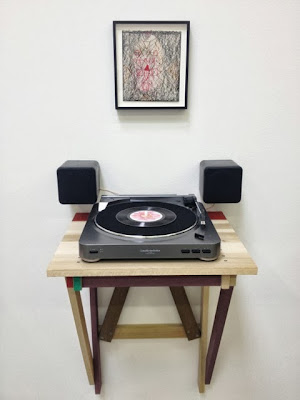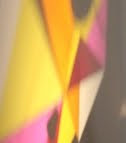symbol / cymbal
the sound piece, cymbal/symbol, appears in different forms in each exhibition. in NY at CRG, the piece includes 3 turntables, 3 records, 6 speakers and 4 drawings. in LA (pictured here), at Susanne Vielmetter LA Projects, the piece includes 4 turntables, 4 records, 8 speakers, and 4 drawings.
this piece began in berlin in 2011 as an 8 channel installation. it was diffused via various small speakers in the space (you can and hear see that first iteration here) and playing continuously.
when i started to think about a sound installation in the presence of my visual works, the idea of a sound installation actively running at all times not only seemed passive, but suggested a soundtrack.
to avoid the passive aspects, i decided that the viewer/listener would have to activate the work themselves, and to offer a relatively determined time-based experience (i.e. when you are looking at records you can literally see the beginning, ending and in between trajectory).
having spent much of my music listening life with vinyl, part of the decision had to do with intimacy - that the duration of a recording on a record is palpable and visible; and so instead of a soundtrack, i thought about the sound piece more like a moment for a visitor to become a performer who would disrupt the silence of the gallery atmosphere through their participation in the realization of the work - particularly as there are numerous ways of experiencing a work that involves starting and stopping a series of records.
certainly, the fact that one person could never start each record at the same time (unless one had 3 or 4 arms!), suggests that one has choices in how they listen or activate the work. when i visited the space yesterday, there were two or three people activating the records together at one time, and another, there was a single person listening to them one by one. i'm interested in a kind of analog/mechanical interactivity, because it doesn't feel distancing (i.e. you know immediately how this is working), and without a "wow" factor, the experience can remain human and intimate. when i was in undergraduate school, i remember a good friend of mine created a "painting" that consisted of a 5 images on wood layered upon two pegs. the idea was that the viewer could pull the paintings off the pegs and put them back in different orders, so that the composition was always changing, even though its parts were "fixed".
a few months ago, i posted on some furniture designed by enzo mari, and the "furniture" for the cymbal/symbol was designed and built by james anderson and brian taylor. i gave james and brian a photograph of the mari table and asked them to riff off of mari's work. in a similar way to how the recordings can be mixed up and/or fit together, the elements that make up the wood pieces and their colors seem also like a potential score.
the score for this piece was built via walter benajmin's "theme symbols" that are prevalent in benjamin's notebook regarding his arcades projects. i used benjamin's symbols to determine actions on a cymbal... such as an X shape determining that i would tap the cymbal in 4 equidistant places; or a circle would determine that i run a violin bow around the edge of the cymbal (essentially drawing a circle in sound). the drawings above the turntables are my own scores, based on benjamin's notes. the page from my own notebook covers all of the symbols i found in the arcades notebook and all were used in the making of the work...
this piece began in berlin in 2011 as an 8 channel installation. it was diffused via various small speakers in the space (you can and hear see that first iteration here) and playing continuously.
when i started to think about a sound installation in the presence of my visual works, the idea of a sound installation actively running at all times not only seemed passive, but suggested a soundtrack.
to avoid the passive aspects, i decided that the viewer/listener would have to activate the work themselves, and to offer a relatively determined time-based experience (i.e. when you are looking at records you can literally see the beginning, ending and in between trajectory).
having spent much of my music listening life with vinyl, part of the decision had to do with intimacy - that the duration of a recording on a record is palpable and visible; and so instead of a soundtrack, i thought about the sound piece more like a moment for a visitor to become a performer who would disrupt the silence of the gallery atmosphere through their participation in the realization of the work - particularly as there are numerous ways of experiencing a work that involves starting and stopping a series of records.
certainly, the fact that one person could never start each record at the same time (unless one had 3 or 4 arms!), suggests that one has choices in how they listen or activate the work. when i visited the space yesterday, there were two or three people activating the records together at one time, and another, there was a single person listening to them one by one. i'm interested in a kind of analog/mechanical interactivity, because it doesn't feel distancing (i.e. you know immediately how this is working), and without a "wow" factor, the experience can remain human and intimate. when i was in undergraduate school, i remember a good friend of mine created a "painting" that consisted of a 5 images on wood layered upon two pegs. the idea was that the viewer could pull the paintings off the pegs and put them back in different orders, so that the composition was always changing, even though its parts were "fixed".
a few months ago, i posted on some furniture designed by enzo mari, and the "furniture" for the cymbal/symbol was designed and built by james anderson and brian taylor. i gave james and brian a photograph of the mari table and asked them to riff off of mari's work. in a similar way to how the recordings can be mixed up and/or fit together, the elements that make up the wood pieces and their colors seem also like a potential score.
the score for this piece was built via walter benajmin's "theme symbols" that are prevalent in benjamin's notebook regarding his arcades projects. i used benjamin's symbols to determine actions on a cymbal... such as an X shape determining that i would tap the cymbal in 4 equidistant places; or a circle would determine that i run a violin bow around the edge of the cymbal (essentially drawing a circle in sound). the drawings above the turntables are my own scores, based on benjamin's notes. the page from my own notebook covers all of the symbols i found in the arcades notebook and all were used in the making of the work...








0 Comments:
Post a Comment
<< Home